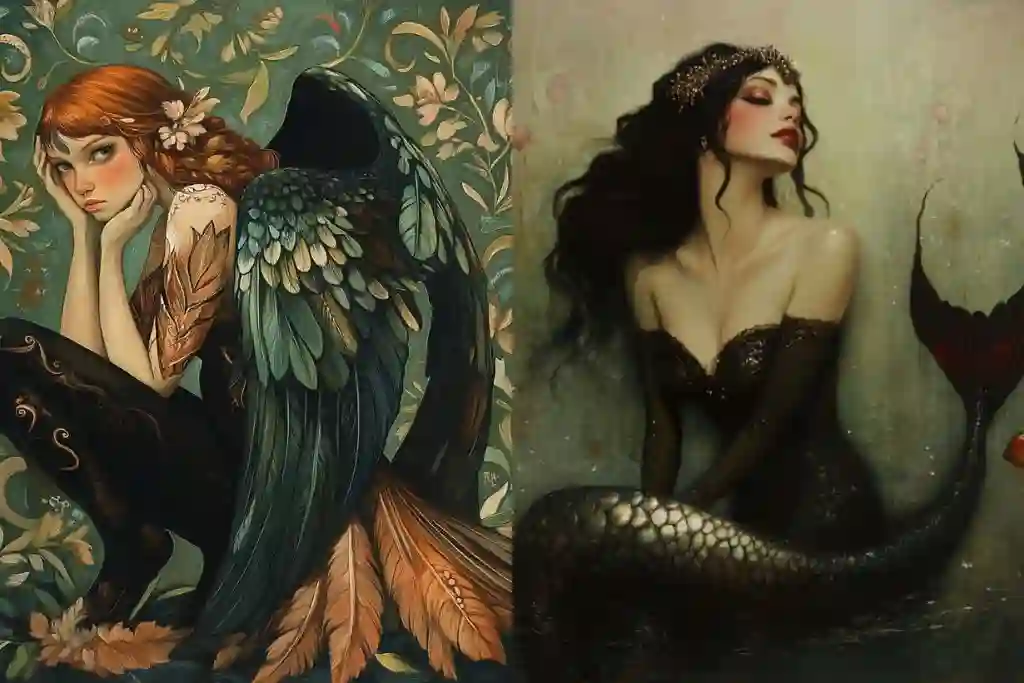Mythology is filled with captivating creatures, each with its own unique allure and terrifying power. Among these, the Sirens and the Harpies stand out as two of the most intriguing, both embodying the seductive and destructive forces of nature. While seemingly different, they share a common thread: the ability to captivate and ultimately consume their victims.
Historical Background
Origins of Sirens
Their story is immortalized in Homer’s “The Odyssey,” where Odysseus cleverly navigates their deadly allure. Originally depicted as bird-like creatures with the heads of women, the depiction of Sirens has evolved over centuries to reflect beautiful mermaid-like figures. Their origins are deeply embedded in ancient tales, serving as cautionary legends illustrating the dangers of seduction and distraction.
Origins of Harpies
Harpies are first mentioned in the works of Greek poets like Hesiod. Often portrayed as wind spirits sent by the gods to torment mortals, Harpies are known for their grotesque appearance and fierce nature. Historically, they have taken on different roles in various myths, most notably as tormentors of King Phineus in the Argonautica. Over time, their image has shifted slightly, but they have remained predominantly as agents of punishment and chaos, symbolizing the relentless forces of nature.
Characteristics of Sirens and Harpies
The Sirens: Songs of Enchantment and Despair
In Greek mythology, Sirens were depicted as beautiful winged creatures, often portrayed as women with bird-like features. Their power lay in their enchanting voices, capable of luring sailors to their doom. Ships sailing near their island would be drawn irresistibly towards the alluring melodies, leading them to crash against the rocky shores.
The Sirens were associated with the allure of pleasure and the dangers of unchecked desire. Their songs represented the seductive temptations that can lead to self-destruction.
Through the ages, and in different cultures, their image has morphed into alluring women, sometimes depicted as mermaids, embodying both the ethereal beauty and hidden danger of the sea. This transformation reflects societal changes, with Sirens often embodying the era’s cultural views on femininity, temptation, and danger.
The Harpies: Wind-like Creatures of Chaos and Destruction
Harpies, on the other hand, were depicted as monstrous creatures with the heads and breasts of women, the bodies of vultures, and bat-like wings. They were associated with storms, winds, and sudden, unpredictable violence. These creatures were known for their foul stench and their habit of snatching food and children away, leaving behind only a trail of devastation.
The Harpies were embodiments of chaos and the unpredictable forces of nature. They represented the sudden and devastating events that can disrupt human lives and bring about suffering. The Harpies were often associated with the Furies, the avenging spirits of Greek mythology, and their presence was a sign of impending doom.
Similarities and Contrasts
Despite their differences, both Sirens and Harpies share a common theme: the destructive power of unchecked impulses. The Sirens represent the allure of pleasure and the dangers of unchecked desire, while the Harpies embody the unpredictable forces of nature and the sudden, devastating events that can disrupt human lives.
Both creatures serve as potent metaphors for the dangers that lie beyond the boundaries of human control. They remind us of the importance of self-control, the need to resist temptation, and the ever-present threat of forces beyond our comprehension.
Symbolism and Cultural Impact
Sirens in Culture and Symbolism
In modern culture, Sirens continue to fascinate as embodiments of seduction and danger. They are frequently seen in literature, films, and art as symbols of alluring temptation—capturing the complex dynamics of attraction and peril. The continuous reinvention of Sirens in different media underscores their enduring resonance as metaphors for distractions and the seductive pulls that may lead one astray.
Harpies in Culture and Symbolism
Harpies, though less romanticized than Sirens, have also left their mark on contemporary media. Often depicted as symbols of wrath and chaos, they appear in various forms ranging from novels to video games. Despite their chilling nature, Harpies’ representation in culture underscores humanity’s fascination with the concept of divine punishment and the embodiment of natural calamities.
Conclusion
As we’ve explored, Sirens and Harpies possess distinct yet profoundly fascinating qualities that continue to captivate our imagination. While Sirens embody the duality of beauty and danger with their seductive songs, Harpies represent the chaotic and relentless forces of nature. Both creatures, with their rich mythological backgrounds and impactful symbolism, hold an enduring allure that invites endless exploration and re-interpretation. Whether as warnings or as captivating myths, they remind us of the timeless human fascination with the unknown and the enchanting power of storytelling.


